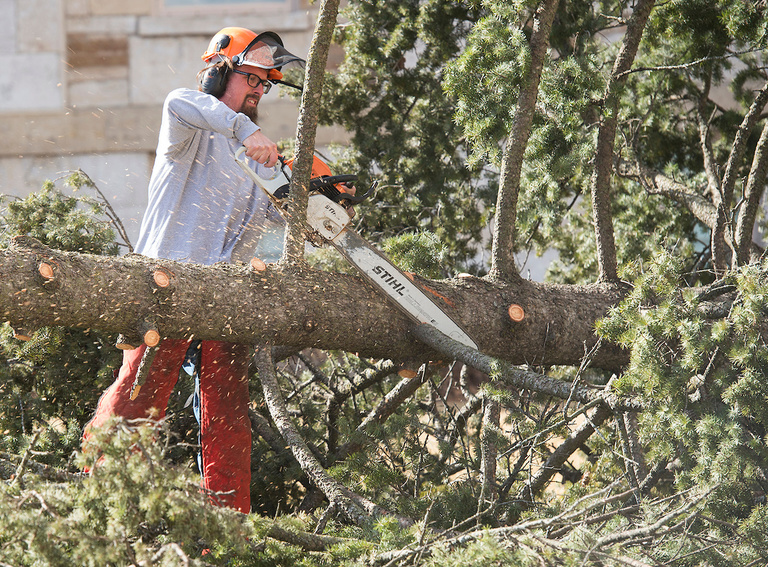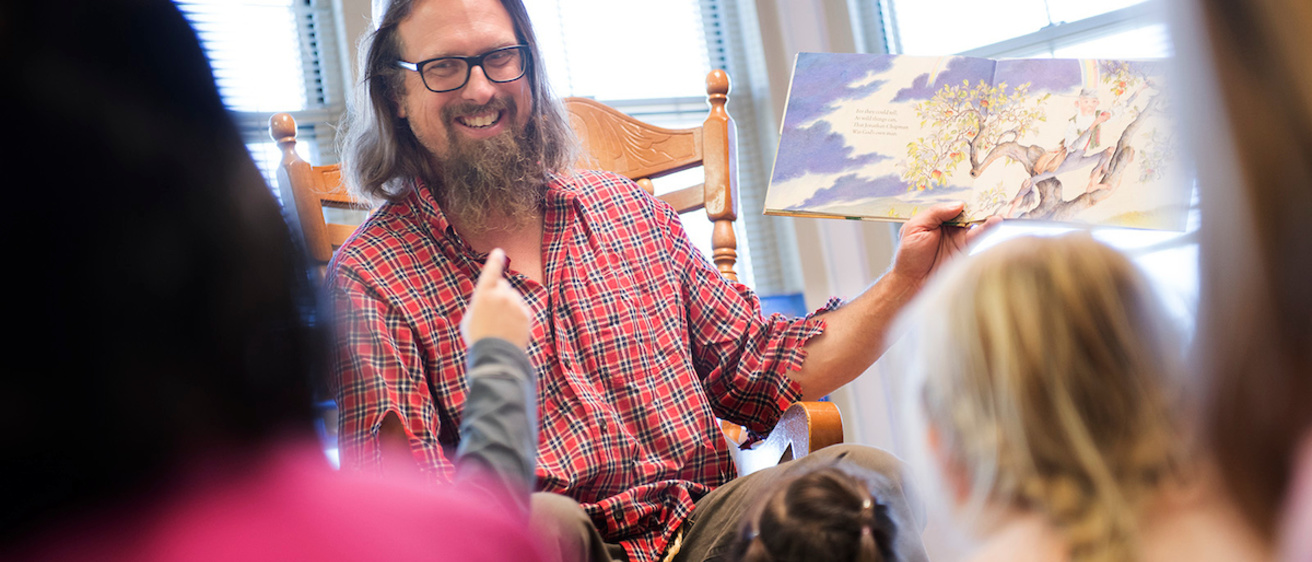Andy Dahl plans his vacations around visiting trees, much to his family’s chagrin. He uses his shotgun to shoot off witch’s brooms—genetic deformities that grow high up in trees—so he can see what they look like up close. His oldest daughter knew the Latin genus and species of trees when she was 3 years old.
Dahl, the University of Iowa’s arborist, has loved trees for as long as he can remember, when he gaped at nine majestic and ancient bur oaks growing in his parents’ yard in Washington, Iowa, one of which he got stuck in once while climbing and needed to be rescued from.

“Maybe that’s foreshadowing,” he now says.
Today, Dahl helps manage the more than 8,000 trees growing on UI property around Iowa City and Coralville. He gets to play in the dirt and wear beat-up clothes to work—torn shorts and T-shirts with the sleeves cut off.
But Dahl didn’t start out on this path. He went to Wartburg College in Waverly, Iowa, for a year, planning to pursue a “responsible” career and majoring in a field he says he can’t remember: “Accounting, or something like that.” But a career behind a desk didn’t interest him, and he decided to pursue something he loved.
Like trees.
When he was 5, he gathered acorns and planted them. About the same time, he took an ax and impulsively tried to cut down a dead bur oak at his grandparents’ house.
“I don’t know why. My family doesn’t know why. I just did it,” he says. “Maybe that was foreshadowing too.”
He worked at a tree care company and started his own tree-related business before transferring to Kirkwood Community College and earning a degree in landscape design. He became the UI’s arborist in 2003.
Want to know more about some of the university’s best and biggest trees? Its old elm and chestnuts? Its state champion walnut? The UI recently released an app that shows the stats of many of the trees around campus. Download it here.
Dahl says the campus has more than 300 species of tree, and he loves pointing them out on a tour.
There’s the American elm on the Pentacrest, a 19th-century giant that’s the lone survivor of the Dutch elm blight. There’s a scarlet oak on Park Drive at Hancher Auditorium that arborists worried wouldn’t survive construction-related trauma, but appears to have made it through OK. And there are the sycamores growing around the 1936 Art Building that no doubt inspired famed artist Grant Wood as he walked to his studio in the 1930s.
There’s the apple tree in a UI orchard grafted from a tree planted by Johnny Appleseed. Another of the orchard’s apples was grafted from one leaned against by Sir Isaac Newton. Dahl presented a graft of that tree as a gift to renowned science author and communicator Neil DeGrasse Tyson during his campus visit last fall, spurring an hour-long conversation about trees. Tyson, it should be noted, is one of Dahl’s heroes, so he was pretty happy about this.
There’s an American chestnut tree on the Oakdale Campus, “a perfect tree,” Dahl says, with a wide canopy and a deeply grooved trunk that is the pride of chestnut trees. The Midwest once was filled with chestnut trees, until they were done in by a blight. This is one of the few survivors.
North of Currier Hall grows a grove of exotic trees that few people visit. There’s the cucumber magnolia with two-tone, green-and-white leaves—not the solid green they should be. (“It’s a freak of nature,” says Dahl, claiming he easily identifies with freaks.) There’s a trident maple that was grafted from a state champion tree in Burlington, Iowa. And there’s a pond cypress that’s found mainly in the South but few know is hearty enough to survive up here in Iowa as well.
There’s an Osage orange, a handful of rubber trees, and a variety of Zelkova, which means “snow on the mountain.”
The university’s commitment to trees has led the Arbor Day Foundation to declare it a Tree Campus USA every year since 2009, the only university or college in the state to receive the designation.
Being an arborist does have a downside, however. Dahl has watched wind storms and tornadoes blow down beautiful trees that he’s had to say goodbye to. He watched 140 trees die from damage incurred during the 2008 flood.
And two members of his team discovered in February that a green ash tree located in Gibson Square was infected by the emerald ash borer. That tree and several other ash nearby soon were cut down and mulched, but that won’t be enough to save the remaining 540 ash trees on campus. The beetle is moving relentlessly across Iowa, and its presence on campus means other trees already are infected. A removal plan developed when the ash borer began its incursion into Iowa has been put into effect, so almost all of the ash trees on campus will be removed within four years.
Dahl’s had to explain often why the university is cutting them down. But he doesn’t mind.
“It’s kind of what we want because it shows people love trees,” he says of the questions.
He explains that every tree removed presents an opportunity for growth.
“We plant two or three new trees for every tree we cut down,” he says. That not only makes the campus more forest-like, it allows the university to add to its species mix, avoiding a monoculture that makes trees more susceptible to contagions such as those that wiped out so many elm and chestnut and, now, ash.
The tree closest to Dahl's heart is the European beech at Danforth Chapel. He and his wife, Brandy, planted it on the day they were married there in 2004. Instead of rice, their guests threw handfuls of dirt around the roots, and he placed two heart-shaped rocks underneath.
“It’s got some scars, it’s seen some life, but it’s survived,” he says. “Just like marriages.”
